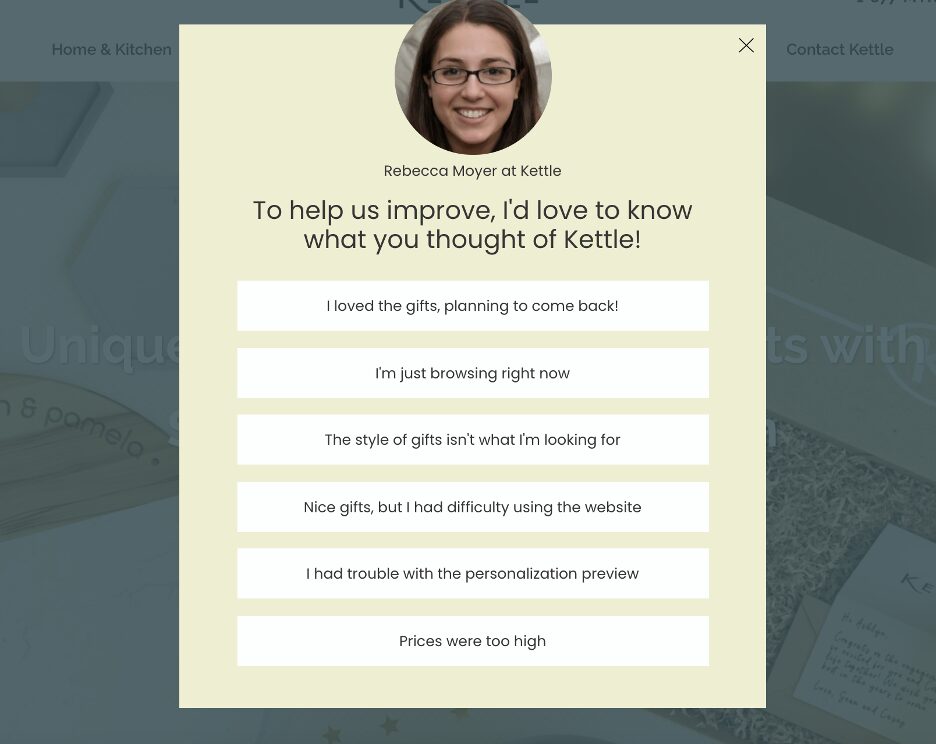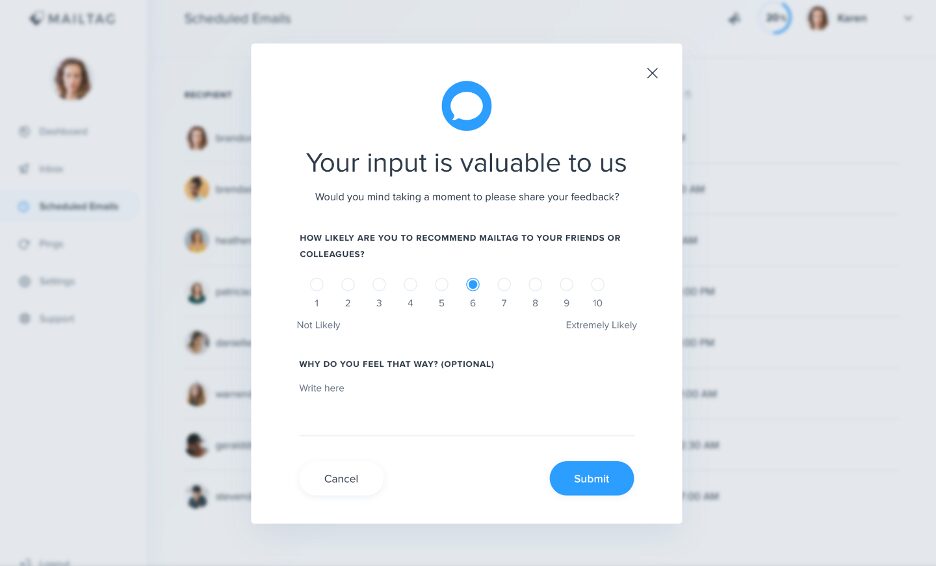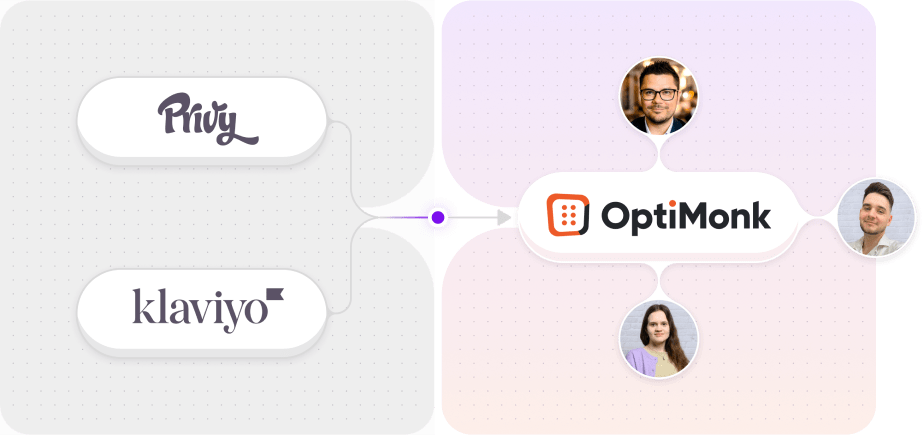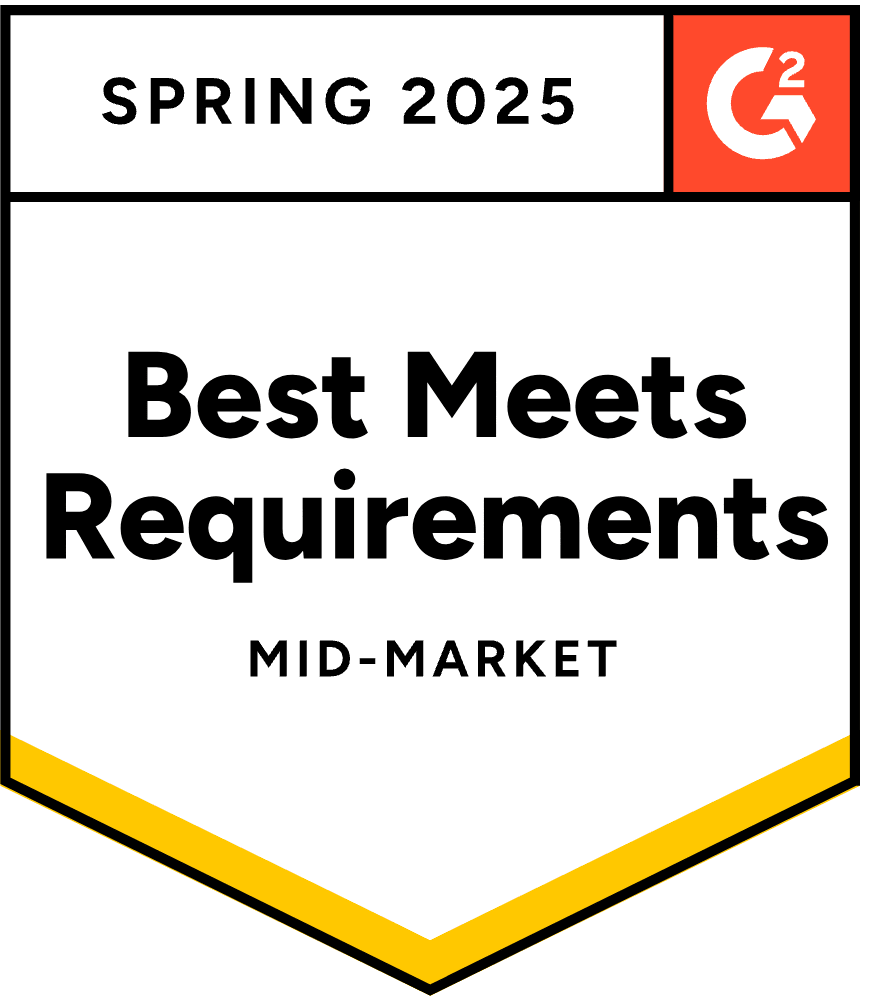- Blog
- Need a Survey Template? Here’s How to Create Survey Popups That Work
Need a Survey Template? Here’s How to Create Survey Popups That Work
-
Barbara Bartucz
- Conversion
- 6 min read
Table of Contents
Collecting customer feedback often feels like an uphill battle. You want valuable insights, but email surveys are often ignored, and asking in person can be cumbersome. What’s the solution?
Survey popups—a quick, non-intrusive way to capture real-time feedback and collect data while your customers are still engaged. In fact, a recent poll in our weekly newsletter revealed that most of our 30,000 subscribers rely on post-purchase feedback forms to gather insights.
If you’re looking for a better way to connect with your audience, survey popups might be the answer. Let’s dive into how to create survey popups that actually work!
What is a survey popup?
A survey popup is a small, interactive window that appears while someone is browsing your website. It’s designed to capture quick customer feedback—whether about a recent purchase, the user experience, or interest in a new feature.
Unlike email surveys, popups gather immediate responses, allowing you to act quickly on the data. Survey popups can be set up in just a few minutes, making them a convenient and efficient option. Many platforms offer free survey templates that can be easily customized to fit your specific needs, helping you quickly gather market research insights.
Why should you use survey popups?
Survey popups are more than just a quick questionnaire. They’re an opportunity to truly understand your customers.
Here’s why you should consider them:
- Real-time feedback: You capture insights while users are actively engaging with your website, making the feedback more relevant and accurate.
- Increased response rates: Let’s face it—email surveys often get buried in inboxes. Popups, on the other hand, are much harder to ignore, leading to more responses.
- Better decision-making: With direct feedback, you can make smarter, data-driven decisions that align with what your customers actually want.
- More data collection: Survey popups allow you to collect more data compared to methods like focus groups, enabling you to control the quality of public opinion and uniformity of responses.
- Increased engagement: Asking for input shows users that you care about their opinions, strengthening their connection with your brand.
Pre-built survey templates
Not sure where to start? OptiMonk offers customizable pre-built survey popup templates. These templates save you time and ensure you’re following best practices.
Various questionnaire templates are available, and you can easily modify them to fit your needs. Adjust the design, questions, and triggers to match your specific requirements.
What are the key components of an effective survey popup?
Creating a successful survey popup isn’t just about asking questions; it’s about how you design, trigger, and present the survey to users.
Here’s what you need to make your popup stand out:
1. Simple, clear design
Design plays a crucial role in how users perceive your survey popup. Keep it clean and minimalist so it doesn’t feel like an interruption. A cluttered popup can frustrate visitors, causing them to close it without reading a single word.
Stick to a simple layout that aligns with your brand’s style. Use your brand colors, fonts, and logo to maintain consistency and build trust. A well-branded popup looks professional and reassures users that their feedback is valued.
Kettle Gifts excels at this with a clean, on-brand design. Their popup is eye-catching yet not overwhelming, making it easy for users to engage.

2. Concise, focused questions
When it comes to survey questions, less is more. Focus on short, relevant questions that are easy to answer. Stick to one or two key questions, and use multiple-choice or net promoter score options for quick feedback.
This makes it easy for users to complete the survey without losing interest. Clear and unbiased questions are essential for accurately gauging public opinion.
Example of focused questions:
- Good: “How satisfied are you with your shopping experience today?”
- Bad: “Please describe in detail your overall satisfaction with each stage of your recent purchase, including product quality, shipping speed, and customer service.”
MailTag’s survey question is a great example—it’s focused and takes seconds to complete, leading to higher completion rates.

3. Eye-catching, not overpowering
Your survey popup needs to catch the user’s eye without disrupting their experience. The key is to strike a balance between noticeable and non-intrusive.
Place your popup strategically, such as in the bottom corner of the page, and use subtle animations or visual cues to draw attention. Bold headings, contrasting colors, and subtle animations make it eye-catching without being disruptive.
Remember, the goal is to invite users to share their thoughts, not to force them. Including a net promoter score question can effectively measure customer loyalty.
4. Clear call-to-action
The CTA is the final step in getting users to complete your survey, so it needs to be strong and clear. Avoid vague or generic language like “Submit” or “Click Here”—these don’t motivate users or increase customer satisfaction.
Instead, use action-oriented language that tells users exactly what to do and why.
Examples of strong CTAs:
- “Share Your Feedback”
- “Help Us Improve”
- “Tell Us What You Think”
These phrases feel more personal and engaging, giving users a sense of contribution and purpose. A strong CTA makes users feel like their input is valuable and that they’re helping to shape a better experience.
When and how to trigger your survey popup?
Timing is crucial for survey popups. A well-timed popup can make the difference between user engagement and indifference.
Trigger your survey popup based on specific user actions to make the interaction feel natural. Effective timing can also make popups a powerful tool for market research and gathering valuable insights.
Good times to trigger a survey popup include:
- After a user completes a purchase
- When a user spends a certain amount of time on a page
- Upon cart abandonment
Avoid displaying a popup the moment users land on your site. Let them settle in first—this makes the interaction feel more intuitive and less disruptive.
4 best practices to create your own survey popup
Creating a survey form that’s not just well-designed but also effective? We’ve got you covered.
Here are four best practices to keep in mind before you design your own survey:
1. Keep it mobile-friendly
With most people browsing on mobile, your survey form needs to be responsive and easy to complete on any device. Use designs that scale to fit smaller screens, and keep the content bite-sized for mobile users.
2. Limit user disruption
A survey shouldn’t interrupt the user’s journey. Make sure the popup can be easily closed or minimized, and avoid showing it during critical moments, like checkout.
3. Incentivize survey completion
Sometimes, people need a little motivation. Offering incentives like a discount code or entry into a giveaway can significantly boost response rates. Who doesn’t love a good deal?
4. A/B test
Your first popup may not be perfect, and that’s okay. Run A/B tests to fine-tune elements like design, question length, and CTA language. Test different triggers and placements to see what drives the most engagement.
How to analyze the data and act on survey results
Gathering information is just the start—what really matters is how you use it in your marketing strategy. Begin by identifying patterns in the feedback. Are there common themes or frequently mentioned concerns?
These insights reveal what’s most important to your audience and can significantly enhance your marketing efforts.
Next, pinpoint specific pain points that need attention. Addressing these issues can lead to quick improvements that boost customer satisfaction and refine your marketing approach. Finally, take concrete action based on the feedback—whether it’s updating a product, tweaking your website, or improving customer service.
Don’t forget to close the loop by letting your customers know you’ve made changes based on their input. This not only builds trust but also encourages them to keep engaging in the future, further strengthening your marketing initiatives.
Wrapping up
Survey popups are an incredibly effective way to gather real-time feedback, boost engagement, and make smarter, data-driven decisions.
By applying these tips and best practices, you’ll be able to create popups that not only capture valuable insights but also deepen your connection with your audience.
Ready to get started? Create your own survey and sign up for a free OptiMonk account to start building high-impact popups today.
Your customers are eager to share their thoughts—don’t keep them waiting!
Migration has never been easier
We made switching a no-brainer with our free, white-glove onboarding service so you can get started in the blink of an eye.

What should you do next?
Thanks for reading till the end. Here are 4 ways we can help you grow your business:
Boost conversions with proven use cases
Explore our Use Case Library, filled with actionable personalization examples and step-by-step guides to unlock your website's full potential. Check out Use Case Library
Create a free OptiMonk account
Create a free OptiMonk account and easily get started with popups and conversion rate optimization. Get OptiMonk free
Get advice from a CRO expert
Schedule a personalized discovery call with one of our experts to explore how OptiMonk can help you grow your business. Book a demo
Join our weekly newsletter
Real CRO insights & marketing tips. No fluff. Straight to your inbox. Subscribe now
Barbara Bartucz
- Posted in
- Conversion
Partner with us
- © OptiMonk. All rights reserved!
- Terms of Use
- Privacy Policy
- Cookie Policy
Product updates: January Release 2025








